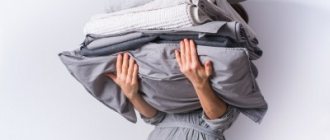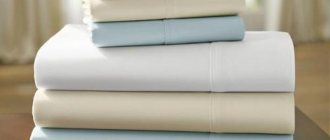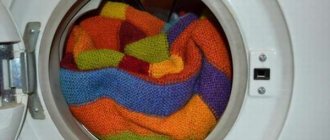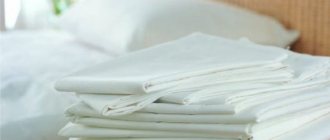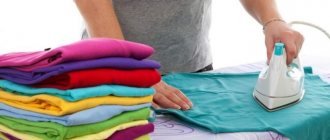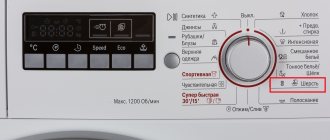Do you know at what temperature to wash bed linen and how to do it correctly? This is exactly what our article will discuss. The pleasant smell and freshness of clean bed linen encourages healthy and sound sleep. However, linen, in contact with the human body, gets dirty quite quickly.
Clean bedding promotes deep sleep
To maintain hygiene and keep your bed clean, you need to regularly wash your bed linen in the washing machine. How often to change pillowcases and sheets and wash them, and what programs to use, you will learn from this material.
We wash it correctly
Inexperienced housewives do not delve into the nuances of washing bed linen. Because of this, sheets and pillowcases quickly lose their freshness and newness. Why does some underwear remain attractive for years, while for others it becomes deformed, loses color saturation, wears out, and becomes covered in pellets? In order for sheets and duvet covers to maintain their appearance, you need to know at what temperature to wash them, in what mode and with what frequency.
Loading
Each washer has its own capacity limit. Drum loading depends on the model. Compact machines are loaded with 3-4 kg, standard machines - 5-9 kg. The user’s task is to load the drum without exceeding the norm. This is the only way to ensure high-quality washing of products.
If your SMA does not have automatic weighing, you have to estimate your weight by eye or calculate it by checking the tables:
- Sheet - 0.4-0.5 kg;
- Duvet cover - 0.5-0.7 kg;
- Bedspread - 0.6-0.8 kg;
- Pillowcase - 0.15-0.25 kg.
When loading, you need to take into account the volume of things - they must rotate freely inside the machine, otherwise the quality of the wash decreases. It is recommended to fill the drum halfway - this way the products will be washed as carefully as possible. By filling the drum to capacity, you risk the beauty of your laundry.
General rules
How to wash bed linen in a machine - general rules for all fabrics:
- White and colored bed linen are washed separately. If you mix it, it is possible that white products will acquire rainbow shades. Moreover, it is very difficult, and sometimes impossible, to return whiteness.
- Things made of the same material are loaded into the drum - cotton separately, linen separately. The choice of washing mode depends on the type of fabric. For each material, SMA has its own program. If you load different fabrics together, pilling may occur. This happens due to the difference in structure: one material is softer, the other is rougher.
- If you are in doubt about which program to wash your clothes on, look at the label - it shows the permissible washing temperature and other care details. Labels with information are on each product - they are attached to the side. To decipher the icons, look at the special table.
- If you just bought a bedding set, don’t lay it out right away - throw it in the machine. You cannot sleep on sheets and pillowcases that came to you from a sewing workshop - this is unhygienic.
- Turn things inside out. If the products have zippers, it is advisable to fasten them all the way so that they do not tear the fabric.
- Children's accessories are placed in the drum separately from adults. They use special powders that do not cause allergies. It is not recommended to put infants' bedding in SMA - it is better to wash them by hand, and without powder. It is advisable to use regular laundry soap. If you still decide to use SMA, do not put the powder - throw shavings of grated soap into the drum.
- Don't overuse bleach. Even the most delicate products have a destructive effect on the fiber structure. Frequent use of bleaching agents shortens the life of fabrics.
Washing secrets
Sleep and well-being depend on the condition of your laundry. Therefore, you need to approach washing responsibly in order to get a clean and fragrant bed.
- Wash with high-quality detergents that do not contain additives harmful to health and wash out well.
- The air conditioner should not be abused. It often has a strong odor, which can interfere with proper rest.
- It is recommended to turn on the extra rinse mode when washing. This is especially true for people with sensitive skin and children.
- The drum must be kept clean and care must be taken to ensure that no dirt accumulates on the door or seal.
- Bed linen should be washed separately from clothes and handkerchiefs. The requirement is dictated by hygiene rules and varying degrees of contamination.
- There is no need to combine washing cotton and synthetics in one batch. As a result, cotton will lose its softness from contact with synthetic fibers, which raise the pile on it.
How to wash clothes made from different fabrics?
The type of fabric determines at what temperature and speed the process should be started and how long it should last. For the manufacture of bedding sets the following is used:
- Cotton;
- Satin;
- Calico;
- Linen;
- Polyester;
- Silk;
- Velvet.
If you don't have SMA, it's very important to know at what degrees a particular tissue wears out. It’s good when you can entrust the choice of temperature to the machine - just select the desired program on the control panel, and the appropriate parameters will be set automatically.
Made from cotton
It is recommended to hand wash a new cotton set in cool water. Subsequently, the temperature is selected depending on the contamination and color:
- For white, select the “cotton” mode, temperature - 60 degrees;
- If things have acquired a grayish tint - 90-95 degrees;
- If there are stubborn stains, start pre-soaking and add bleach to the container;
- Colored clothes are washed at 40 degrees - this is enough to wash cotton without losing the brightness of its color.
Cotton is not loaded together with synthetics - synthetic fibers cling to softer, natural fibers, making the fabric less pleasant to the touch. Cotton is dried outside, inside out. There should be no direct rays - they do not have the best effect on the fabric. Cotton items should be ironed slightly under-dried. The ironing side is the front side, embroidery is ironed from the wrong side.
Made from linen
The recommended temperature for linen products is 60 degrees. For white, universal powders are used; for colors, delicate detergents for delicate fabrics are used. Check the composition - options without bleaches are suitable. To improve the properties of linen fabric, it is impregnated with starch, fats, cellulose ethers, synthetic resins and other substances. Impregnation makes linen more resistant to shrinkage and deformation and wrinkles less. The recommended temperature is 40 degrees.
To make linen wash better, it is soaped and left in warm water for one hour. Then pour the powder and a tablespoon of vinegar into the water. Wash, rinse in cold water and dry. Soaked flax should not be dried on radiators or in special dryers - it may shrink. Iron, moistening the fabric. It is easier to iron under-dried items.
Satin
Satin is as pleasant to the touch as silk, but it is more durable. Suitable mode is “cotton” 60 °C. When using powders with active substances, 40 °C can be used. Press at medium and maximum speed. Dry and iron in the same way as cotton.
Silk
Silk is more expensive than satin. In order not to spoil an expensive silk set, set the “delicate/hand wash 30 °C” mode. The powder is special for silk. The softener is poured into a separate tray. Bleach is strictly prohibited. Spin - do not use, or set to minimum speed.
When washing by hand, the silk is not rubbed, but only rinsed thoroughly - successively in warm and cold water. Then rinse with water and vinegar to keep the paint fresh. The dosage of vinegar is a teaspoon per 3 liters of water. Dry only in the shade. Do not move close to radiators; dryers are prohibited. The best place is outside, out of direct sunlight. Ironing - reverse side only, at moderate temperature. Do not splash water - stains may remain.
Made from synthetics
Sleeping on synthetics is not very beneficial. But synthetic kits have many advantages:
- They are cheap;
- Do not wrinkle;
- Unpretentious;
- Durable.
In a word - a budget option that does not require special care. Manufacturers mix natural and synthetic fibers to create good underwear. If the composition contains a lot of synthetics, 30-40 °C is sufficient when washing. Hot water causes pellets to appear. Do not use powders with bleaches. It is forbidden to boil. Drying on hot radiators and hot ironing are also prohibited. The maximum heating of the iron is 50 °C.
Made of velvet
Washing machine is contraindicated for velvet. However, such underwear is rare - it is for “gourmets”. The velvet is not rubbed or twisted, and is handled as gently as possible. Temperature - up to 30 degrees. Instead of powder - gel. You can't squeeze it. Dry, spread out on the table, on a large towel. Roll it up and press down a little so that the water comes out. After changing the towel, repeat the process.
Dry in a horizontal position or hang in the shade. When the velvet is dry, shake it so that the pile settles correctly.
Drying Features
It is important not only to wash and dry sheets and duvet covers correctly. Follow these simple recommendations:
- Do not leave duvet covers, pillowcases and sheets in the machine drum. Hang them up immediately, otherwise they will smell unpleasant.
- Do not bend, but hang the products along their entire length.
- Fasten with clothespins in invisible places so that traces of them remain invisible.
- It is better to dry bed linen on the street or balcony, but not in direct sunlight. Choose a shaded place.
- Linen should be ironed while still damp. If the sheets and duvet covers are completely dry, spray them with water or use the steam function during ironing. Silk underwear should be ironed inside out.
If you want your bedding set to last for a long time, study the label and general washing rules. Following simple rules will help maintain an attractive appearance or snow-white color.
How often should I wash?
The frequency of washing in each home is different. It is influenced by the intensity of use, the presence of children and pets in the house, personal preferences and views on cleanliness. Here are some useful tips:
- Throw your sheets and pillowcases in the wash at the first sign of loss of freshness. It is recommended to do this weekly. Duvet covers get dirty less, so you can run a gentle 30-degree program for them.
- If the frequency of water procedures is less than once a week, set the regime for a specific type of fabric and take into account the degree of contamination.
- You shouldn’t store a dirty set in a basket for a long time - while it lies there crumpled, dirt will eat into it intensely. It will be more difficult to wash such a set, and also to iron it.
What should be the washing frequency?
The question of how often to wash bed linen is asked by many housewives. Our grandmothers did not do this often, because all operations were performed manually and there were no such powders as there are now. Washing took a long time and began with soaking and removing stains. Then the linen was boiled, washed and wrung out by hand.
In the era of washing machines and, especially, automatic machines, washing has ceased to be a problem and the life of housewives has become much easier. It is enough to sort and arrange the laundry for storage, add detergent and turn on the program. There are no restrictions and can be washed at any time as needed.
- It is recommended to wash the laundry when the first signs of contamination appear.
- According to hygiene rules, pillowcases should be washed every 7 days.
- Many people are interested in whether new bedding needs to be washed. Yes, after purchasing the bedding set, you should wash it immediately or just before use.
- There is no need to keep dirty bed linen crumpled in a basket for a long time.
- After guests and one use, the linen also needs to be washed.
- Only clean laundry should be stored.
- You can change the bed every 7-10 days and wash it in a more gentle mode. Then the fibers wear out less and the bedding set will last longer.
- During the summer, the bed should be changed weekly.
- Ironing bed linen is an additional plus, but not everyone agrees with it. And why iron bed linen, and what the pros and cons may be.
Clean bed linen means healthy sleep and comfort and should be taken care of regularly.
When is ironing required?
Ironing large items is extremely tiring. There are SMAs that provide easy ironing and anti-crease functions. After the automated processes carried out by CMA, ironing duvet covers manually seems like an unaffordable waste of time. Everyone decides for themselves whether to iron or not. We will just name the situations in which it is better to go over the bedding with a hot iron:
- If someone in the household is sick. Ironing is necessary to prevent the infection from being transmitted through the bed. It is recommended to provide the patient with separate supplies.
- Kits used for children up to one year old.
- With high humidity, in which things cannot dry completely.
We separate one from the other according to the type of fabric
For the different materials from which clothes are made, there are certain recommendations for choosing a washing product and choosing the right mode. Some categories can be combined, but there are materials that are best washed separately or even by hand.
Suitable for co-washing:
- cotton, linen, chintz items;
- wool and cashmere clothing;
- synthetics cannot be combined with other types - polyester, nylon, acrylic, polyamide, viscose, synthetic velor.
But fleece, artificial silk, tulle, silk, and lace belong to a separate category and cannot be combined at all.
Delicate fabrics should always be washed separately, preferably by hand. For these cases, purchase special products separately and pay special attention to studying the label from the manufacturer.
Helpful information
Tips for washing bed linen:
- Do not overload the drum by more than 2/3. Otherwise, the quality of the wash will be worse.
- After the machine emits a signal indicating the end of the wash, the laundry must be removed immediately. The longer it remains in the drum, the more likely it is to shed.
- If a person is sick, it is recommended to change his bed linen every 1-2 days. When this is not possible, it is necessary to at least wash the pillowcase. Many viruses and bacteria settle on the fabric, which pose a threat of infection. Washing should be done at high temperatures.
You will find a lot of useful and important information about washing bedding in this section.
Removing difficult stains
To combat difficult stains, it is not necessary to use aggressive detergents. Available and inexpensive substances that everyone has in their home come to the rescue:
Blood. It can be removed using hydrogen peroxide, which is applied to a cotton pad and wiped with it until the stain disappears completely.- Urine, sweat and other secretions .
Baking soda and vinegar work well with such stains. They are applied one by one to the fabric, wait until the foaming reaction ends, leave for 30 minutes and wash as usual. - Oily spots . They can be easily removed using a mixture of salt and starch. The powder is applied to the stain, left for an hour, and then washed.
- Cosmetics stains . The most accessible means for removing them is laundry soap. It is grated, diluted with water and applied to the stain as a paste. After 30 minutes the item needs to be washed.
- Wine, coffee, tea . You can neutralize the coloring pigment with ammonia. It is applied to a cotton pad, which is used to wipe the stain until it disappears completely.
Important nuances of choosing a product
- Bed linen is purchased mainly from natural fabric. Low-foam washing powder is better for it. If you cannot do without bleaching, then the powder should be with bleach or a wash enhancer, also in powder form.
- It is important to know the water hardness in your area. Clothes cannot be washed well in hard water. If the water is of medium or high hardness, then you need to use a special detergent. The packaging usually warns that the powder contains a water softener, helps reduce its hardness, and protects the machine from scale. The product itself will need 20% more compared to washing in soft water.
- With soft water there are no problems with washing quality, and detergents will be used sparingly.
- Bedding sets for newborns and children up to three years of age are washed with special detergents. It is advisable that they be selected according to the child’s age.
- People with allergies often have a reaction to powder dust or fragrance. In this case, it is better to use liquid detergents.
- If you prefer a concentrated product, then do not forget about the strict dosage. “Too much” causes excessive foaming in the machine and is difficult to rinse out of the fabric.
Important! Do not use detergent that has expired. The chemical components it contains may change and become harmful to humans.
Preparation for the process
Preparing bed linen for washing is a mandatory condition that should not be neglected.
Basic recommendations:
Go through your laundry, sorting it by color and fabric type. White, light, colored and black items are washed separately.- Separate the laundry into sets if they have different colors.
- Study the manufacturer's information on the label.
- Shake the product several times to remove dust.
- Turn pillowcases, duvet covers and mattress covers inside out. Remove dirt that has accumulated in the corners.
If there are difficult stains on the fabric, for example from blood or wine, they need to be washed in advance.

